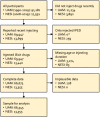The characteristics of people who inject drugs in the United Kingdom: changes in age, duration, and incidence of injecting, 1980-2019, using evidence from repeated cross-sectional surveys
- PMID: 35546310
- PMCID: PMC9544601
- DOI: 10.1111/add.15911
The characteristics of people who inject drugs in the United Kingdom: changes in age, duration, and incidence of injecting, 1980-2019, using evidence from repeated cross-sectional surveys
Abstract
Background and aims: Mortality and drug treatment data suggest that the median age of people who inject drugs is increasing. We aimed to describe changes in the characteristics of people injecting drugs in the United Kingdom (UK).
Design: Repeat cross-sectional surveys and modelling.
Setting: Low-threshold services in the United Kingdom such as needle and syringe programmes.
Participants: A total of 79 900 people who recently injected psychoactive drugs in the United Kingdom, recruited as part of the Unlinked Anonymous Monitoring Survey (England, Wales, Northern Ireland, 1990-2019) and Needle Exchange Surveillance Initiative (Scotland, 2008-2019).
Measurements: Age of people currently injecting, age at first injection, duration of injecting (each 1990-2019) and estimates of new people who started injecting (1980-2019).
Findings: In England, Wales and Northern Ireland between 1990 and 2019, the median age of people injecting increased from 27 (interquartile range [IQR], 24-31) to 40 (IQR, 34-46); median age at first injection increased from 22 (IQR, 19-25) to 33 (IQR, 28-39); and median years of injecting increased from 7 (IQR, 3-11) to 18 (IQR, 9-23). Values in Scotland and England were similar after 2008. The estimated number that started injecting annually in England increased from 5470 (95% prediction interval [PrI] 3120-6940) in 1980 to a peak of 10 270 (95% PrI, 8980-12 780) in 1998, and then decreased to 2420 (95% PrI, 1320-5580) in 2019. The number in Scotland followed a similar pattern, increasing from 1220 (95% PrI, 740-2430) in 1980 to a peak of 3080 (95% PrI, 2160-3350) in 1998, then decreased to a 270 (95% PrI, 130-600) in 2018. The timing of the peak differed between regions, with earlier peaks in London and the North West of England.
Conclusions: In the United Kingdom, large cohorts started injecting psychoactive drugs in the 1980s and 1990s and many still inject today. Relatively few people started in more recent years. This has led to changes in the population injecting drugs, including an older average age and longer injecting histories.
Keywords: Ageing; United Kingdom; demography; epidemiology; heroin; injecting; modelling.
© 2022 The Authors. Addiction published by John Wiley & Sons Ltd on behalf of Society for the Study of Addiction.
Figures





Similar articles
-
Changing age profile and incidence of injecting drug use initiation among people in Australia who inject drugs: evidence from two national repeated cross-sectional studies.Lancet Reg Health West Pac. 2025 Apr 17;57:101548. doi: 10.1016/j.lanwpc.2025.101548. eCollection 2025 Apr. Lancet Reg Health West Pac. 2025. PMID: 40297570 Free PMC article.
-
Investigating the sociodemographic and behavioural factors associated with hepatitis C virus testing amongst people who inject drugs in England, Wales and Northern Ireland: A quantitative cross-sectional analysis.Int J Drug Policy. 2022 Nov;109:103821. doi: 10.1016/j.drugpo.2022.103821. Epub 2022 Aug 20. Int J Drug Policy. 2022. PMID: 35994940
-
Preliminary indications of the burden of COVID-19 among people who inject drugs in England and Northern Ireland and the impact on access to health and harm reduction services.Public Health. 2021 Mar;192:8-11. doi: 10.1016/j.puhe.2021.01.004. Epub 2021 Jan 15. Public Health. 2021. PMID: 33601307 Free PMC article.
-
Epidemiology of injecting drug use, prevalence of injecting-related harm, and exposure to behavioural and environmental risks among people who inject drugs: a systematic review.Lancet Glob Health. 2023 May;11(5):e659-e672. doi: 10.1016/S2214-109X(23)00057-8. Epub 2023 Mar 27. Lancet Glob Health. 2023. PMID: 36996857
-
Frequency of injecting among people who inject drugs: A systematic review and meta-analysis.Int J Drug Policy. 2020 Feb;76:102619. doi: 10.1016/j.drugpo.2019.102619. Epub 2019 Dec 18. Int J Drug Policy. 2020. PMID: 31864107
Cited by
-
Changing age profile and incidence of injecting drug use initiation among people in Australia who inject drugs: evidence from two national repeated cross-sectional studies.Lancet Reg Health West Pac. 2025 Apr 17;57:101548. doi: 10.1016/j.lanwpc.2025.101548. eCollection 2025 Apr. Lancet Reg Health West Pac. 2025. PMID: 40297570 Free PMC article.
-
Burden and treatment of chronic obstructive pulmonary disease among people using illicit opioids: matched cohort study in England.BMJ Med. 2022 Sep 28;1(1):e000215. doi: 10.1136/bmjmed-2022-000215. eCollection 2022. BMJ Med. 2022. PMID: 36568709 Free PMC article.
-
Differences in heroin overdose deaths in Australia by age, 2020-2022: Disease and estimated survival times.Drug Alcohol Depend Rep. 2024 Jan 20;10:100217. doi: 10.1016/j.dadr.2024.100217. eCollection 2024 Mar. Drug Alcohol Depend Rep. 2024. PMID: 38332901 Free PMC article.
-
Improving hospital-based opioid substitution therapy (iHOST): protocol for a mixed-methods evaluation.NIHR Open Res. 2024 Nov 6;4:10. doi: 10.3310/nihropenres.13534.2. eCollection 2024. NIHR Open Res. 2024. PMID: 39568556 Free PMC article.
-
Addressing the Health Needs of People Who Inject Drugs: A Descriptive Analysis of an Inpatient Integrated Care Team Within an Acute Hospital in Scotland.Open Forum Infect Dis. 2025 Mar 11;12(4):ofaf147. doi: 10.1093/ofid/ofaf147. eCollection 2025 Apr. Open Forum Infect Dis. 2025. PMID: 40242061 Free PMC article.
References
-
- Office for National Statistics . Number of deaths related to drug poisoning where any opiate was mentioned on the death certificate, by single year of age, England and Wales, registered between 1993 and 2018. 2019. https://www.ons.gov.uk/peoplepopulationandcommunity/birthsdeathsandmarri... (accessed 22 Jul 2020).
-
- Public Health England . Substance misuse treatment for adults: statistics 2019 to 2020. 2020. https://www.gov.uk/government/statistics/substance-misuse-treatment-for-... (accessed 11 Jun 2021).
-
- Johnston L, Liddell D, Browne K, Priyadarshi S. Responding to the needs of ageing drug users. 2017. https://www.emcdda.europa.eu/system/files/attachments/6225/EuropeanRespo... (accessed 8 Jul 2021).
-
- Australian Bureau of Statistics . Drug Induced Deaths in Australia: A changing story. 2018. https://www.abs.gov.au/ausstats/abs@.nsf/Lookup/by%20Subject/3303.0~2016... (accessed 19 Nov 2019).
Publication types
MeSH terms
Grants and funding
LinkOut - more resources
Full Text Sources

